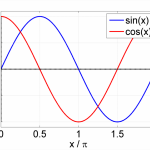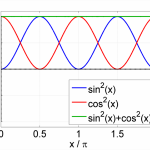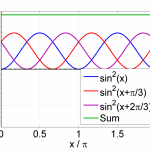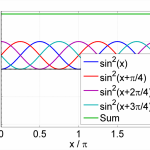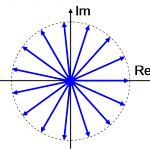I am posting since since we were recently made aware of an error in our journal paper “Deterministic Cramer-Rao Bound for Strictly Non-Circular Sources and Analytical Analysis of the Achievable Gains” (T-SP vol. 64, no. 17). Unfortunately, T-SP does not allow (yet?) to publish errata alongside the original papers, nor to send updates. Therefore, right now the best we can do is to update the arxiv version and inform the community via this blog post.
In fact, the error is more or less a copy-paste error from the earlier conference version “Deterministic Cramér-Rao Bounds for strict sense non-circular sources” (WSA 2007) that contains the same error, although harder to spot.
As the title says, both papers are concerned with Deterministic Cramér-Rao Bounds (CRBs) for strictly non-circular sources. A closed-form expression of the CRB was derived and given by the expression (8) in WSA2007, which reads as
$$\begin{align}
\newcommand{ma}[1]{{\mathbf {#1}}}
\ma{C} = & \frac{\sigma^2}{2N} \Big\{ \left(\ma{G}_2-\ma{G}_1 \ma{G}_0^{-1} \ma{G}_1^T \right) \odot \ma{\hat{R}}_{S,0}
\\ & + \left[ \left( \ma{G}_1 \ma{G}_0^{-1} \ma{H}_0 \right) \odot \ma{\hat{R}}_{S,0} \right] \left[ \left( \ma{G}_0-\ma{H}_0^T \ma{G}_0^{-1} \ma{H}_0 \right) \odot \ma{\hat{R}}_{S,0} \right]^{-1}
\\ & \cdot \left[ \left(\ma{H}_1^T- \ma{H}_0^T \ma{G}_0^{-1} \ma{G}_1^T \right) \odot \ma{\hat{R}}_{S,0} \right]
\\ & + \left[ \ma{H}_1 \odot \ma{\hat{R}}_{S,0} \right] \cdot \left[ \ma{G}_0 \odot \ma{\hat{R}}_{S,0} \right]^{-1} \cdot \left[ \left( \ma{H}_0^T \ma{G}_0^{-1} \ma{G}_1^T \right) \odot \ma{\hat{R}}_{S,0} \right]
\\ & + \left[ \ma{H}_1 \odot \ma{\hat{R}}_{S,0} \right] \cdot \left[ \ma{G}_0 \odot \ma{\hat{R}}_{S,0} \right]^{-1}
\cdot \left[ \left( \ma{H}_0^T \ma{G}_0^{-1} \ma{H}_0 \right) \odot \ma{\hat{R}}_{S,0} \right]
\\& \cdot \left[ \left( \ma{G}_0-\ma{H}_0^T \ma{G}_0^{-1} \ma{H}_0 \right) \odot \ma{\hat{R}}_{S,0} \right]^{-1}
\cdot \left[ \left( \ma{H}_0^T \ma{G}_0^{-1} \ma{G}_1^T \right) \odot \ma{\hat{R}}_{S,0} \right]
\\ &-\left[ \ma{H}_1 \odot \ma{\hat{R}}_{S,0} \right] \cdot \left[ \left( \ma{G}_0-\ma{H}_0^T \ma{G}_0^{-1} \ma{H}_0 \right) \odot \ma{\hat{R}}_{S,0} \right]^{-1}
\cdot \left[ \ma{H}_1^T \odot \ma{\hat{R}}_{S,0} \right] \Big\}^{-1}, \end{align}$$
where the matrices $\ma{G}_i, \ma{H}_i$ for $i=0, 1, 2$ are all of size $d \times d$ and given by
$$\begin{eqnarray}
\ma{G}_0 & = & {\rm Re}\{\ma{\Psi}^* \cdot \ma{A}^H \cdot \ma{A} \cdot \ma{\Psi}\} \\
\ma{H}_0 & = & {\rm Im}\{\ma{\Psi}^* \cdot \ma{A}^H \cdot \ma{A} \cdot \ma{\Psi}\} \\
\ma{G}_1 & = & {\rm Re}\{\ma{\Psi}^* \cdot \ma{D}^H \cdot \ma{A} \cdot \ma{\Psi}\} \\
\ma{H}_1 & = & {\rm Im}\{\ma{\Psi}^* \cdot \ma{D}^H \cdot \ma{A} \cdot \ma{\Psi}\} \\
\ma{G}_2 & = & {\rm Re}\{\ma{\Psi}^* \cdot \ma{D}^H \cdot \ma{D} \cdot \ma{\Psi}\} \\
\ma{H}_2 & = & {\rm Im}\{\ma{\Psi}^* \cdot \ma{D}^H \cdot \ma{D} \cdot \ma{\Psi}\}.
\end{eqnarray}$$
All nice and good, no problem so far. It was then though said in Section 4 how to generalize this to 2-D, where it was claimed that all we need to do is to replace $\ma{D} \in \mathbb{C}^{M \times d}$ by $\ma{D}_{{\rm 2D}} \in \mathbb{C}^{M \times 2d}$ and $\ma{\hat{R}}_{S,0}$ by $\ma{1}_{2 \times 2} \otimes \ma{\hat{R}}_{S,0}$. Well, the first statement is correct, the second one only partially. Unfortunately this went unnoticed into the TSP2016 paper, where the expression is given for $R$-D.
Why is it wrong? Well, you can see that for $R$-D, the size of $\ma{A}$ is unaffected while $\ma{D}$ goes from having $d$ columns to having $R\cdot d$ columns. Therefore, the size of $\ma{G}_0$ and $\ma{H}_0$ is unaffected ($d\times d$) whereas $\ma{G}_1$ and $\ma{H}_1$ are now $R \cdot d \times d$ and $\ma{G}_2$ and $\ma{H}_2$ are now $R\cdot d \times R\cdot d$. To make the CRB work, the augmentation of of $ \ma{\hat{R}}_{S,0} $ has to be done such that it is consistent with the dimensions of the $\ma{G}_i$ and $\ma{H}_i$.
Concretely, this means that $ \left(\ma{G}_2-\ma{G}_1 \ma{G}_0^{-1} \ma{G}_1^T \right) \odot \ma{\hat{R}}_{S,0} $ changes into $ \left(\ma{G}_2-\ma{G}_1 \ma{G}_0^{-1} \ma{G}_1^T \right) \odot \left(\ma{1}_{R\times R} \otimes \ma{\hat{R}}_{S,0}\right) $, which is the example treated in the paper. However, $ \left( \ma{G}_1 \ma{G}_0^{-1} \ma{H}_0 \right) \odot \ma{\hat{R}}_{S,0} $ becomes $ \left( \ma{G}_1 \ma{G}_0^{-1} \ma{H}_0 \right) \odot \left(\ma{1}_{R \times {\color{red}1}} \otimes \ma{\hat{R}}_{S,0} \right)$ and $ \left( \ma{G}_0-\ma{H}_0^T \ma{G}_0^{-1} \ma{H}_0 \right) \odot \ma{\hat{R}}_{S,0} $ remains unaffected.
Long story short, here is the corrected version of the R-D CRB (equation (15) in TSP2016):
$$\begin{align}
\newcommand{ma}[1]{{\mathbf {#1}}}
\ma{C} = & \frac{\sigma^2}{2N} \Big\{ \left(\ma{G}_2-\ma{G}_1 \ma{G}_0^{-1} \ma{G}_1^T \right) \odot \left(\ma{1}_{R\times R} \otimes \ma{\hat{R}}_{S,0} \right)
\\ & + \left[ \left( \ma{G}_1 \ma{G}_0^{-1} \ma{H}_0 \right) \odot \left(\ma{1}_{R\times 1} \otimes \ma{\hat{R}}_{S,0} \right)\right] \left[ \left( \ma{G}_0-\ma{H}_0^T \ma{G}_0^{-1} \ma{H}_0 \right) \odot \ma{\hat{R}}_{S,0} \right]^{-1}
\\ & \cdot \left[ \left(\ma{H}_1^T- \ma{H}_0^T \ma{G}_0^{-1} \ma{G}_1^T \right) \odot \left(\ma{1}_{1\times R} \otimes \ma{\hat{R}}_{S,0}\right) \right]
\\ & + \left[ \ma{H}_1 \odot \left(\ma{1}_{R\times 1} \otimes \ma{\hat{R}}_{S,0}\right) \right] \cdot \left[ \ma{G}_0 \odot \ma{\hat{R}}_{S,0} \right]^{-1} \cdot \left[ \left( \ma{H}_0^T \ma{G}_0^{-1} \ma{G}_1^T \right) \odot \left(\ma{1}_{1\times R} \otimes \ma{\hat{R}}_{S,0} \right) \right]
\\ & + \left[ \ma{H}_1 \odot \left(\ma{1}_{R\times 1} \otimes \ma{\hat{R}}_{S,0}\right) \right] \cdot \left[ \ma{G}_0 \odot \ma{\hat{R}}_{S,0} \right]^{-1}
\cdot \left[ \left( \ma{H}_0^T \ma{G}_0^{-1} \ma{H}_0 \right) \odot \ma{\hat{R}}_{S,0} \right]
\\& \cdot \left[ \left( \ma{G}_0-\ma{H}_0^T \ma{G}_0^{-1} \ma{H}_0 \right) \odot \ma{\hat{R}}_{S,0} \right]^{-1}
\cdot \left[ \left( \ma{H}_0^T \ma{G}_0^{-1} \ma{G}_1^T \right) \odot \left(\ma{1}_{1\times R} \otimes \ma{\hat{R}}_{S,0} \right) \right]
\\ &-\left[ \ma{H}_1 \odot \left(\ma{1}_{R\times 1} \otimes \ma{\hat{R}}_{S,0}\right) \right] \cdot \left[ \left( \ma{G}_0-\ma{H}_0^T \ma{G}_0^{-1} \ma{H}_0 \right) \odot \ma{\hat{R}}_{S,0} \right]^{-1}
\cdot \left[ \ma{H}_1^T \odot \left(\ma{1}_{1\times R} \otimes \ma{\hat{R}}_{S,0}\right) \right] \Big\}^{-1}. \end{align}$$
The pattern is clear: the “outer” terms get expanded, while the “inner” terms remain unaffected.
We would like to thank Mr. Tanveer Ahmed for noticing the mistake! We sure hope we got it right this time! 🙂
